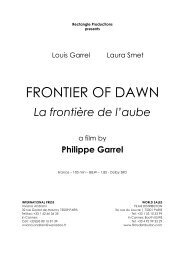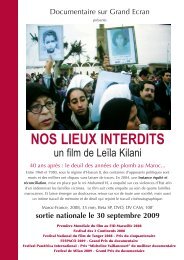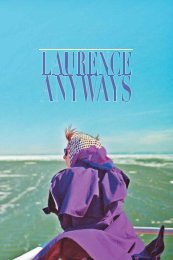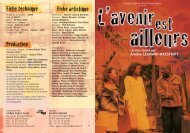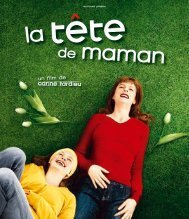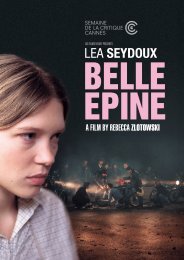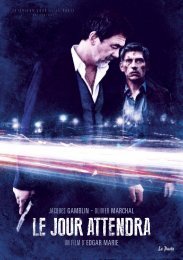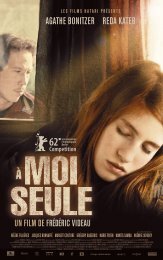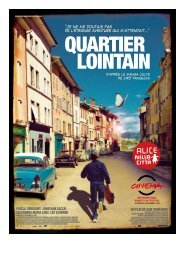MAN AT BATH
Here - Unifrance
Here - Unifrance
You also want an ePaper? Increase the reach of your titles
YUMPU automatically turns print PDFs into web optimized ePapers that Google loves.
STORY OF THE FILM<br />
Between the Paris suburbs and New York, Omar and Emmanuel do everything they can to prove to each<br />
other that they are no longer in love.<br />
STORY OF THE SHOOT<br />
Certain films happen unexpectedly. That doesn’t mean that there is any less desire behind<br />
them; just that their production is organized at a pace and in ways that are unforeseen, given<br />
that the film emerges there where you only thought of “trying something”. That was the case<br />
for this film. It was a strange and joyful experience to find oneself directing a film that is at<br />
once intimate and, I hope, accessible to everyone. The skills I acquired with the films I’ve<br />
shot before certainly allowed me to have this relaxed freedom, meaning I could write freely.<br />
Like all filmmakers, I know only too well the endless difficulties in putting together a<br />
feature-length film, which meant I could revel in the insolent way this one came together.<br />
As someone from Brittany, I’ve always struggled to think of the Parisian suburbs as anything<br />
other than a province where Paris is accessible yet untouchable. I come from a province<br />
where Paris is a far-off place that one fantasizes about and dreams of. I had this somewhat<br />
facile idea that a province so close to Paris – at arms length, but nonetheless ignored – does<br />
not result in dreams, but in frustration; a logic based on humiliation and defeat. One which<br />
conjures vengeance rather than desire. I wanted to seize on an invitation from Pascal<br />
Rambert to shoot at Gennevilliers to overcome my preconceived ideas about a suburb that<br />
must surely be envious. And in choosing the neighborhood considered one of the hottest in<br />
town (Le Luth, where the municipality, for this very reason, chose not to grant us permission<br />
to film), I wanted to treat the word “hot” more in an erotic sense than violent, which it can<br />
mean in French. I imagined a utopian setting there, where desires are expressed without<br />
fear.<br />
I had no images of Gennevilliers, apart from that of the theatre and its impressive hall and<br />
the containers on the port where I illegally photographed a friend shortly after arriving in<br />
Paris. But the name Gennevilliers inevitably evokes the name of the artist Gustave<br />
Caillebotte, who lived there for many years. Then this painting comes to mind, Homme au<br />
Bain (Man at Bath). In it, we see a man from behind drying himself with a gray towel in a<br />
white room by a zinc bathtub. He has just climbed out if the bath. His wet feet leave traces<br />
on the floor. This was quite a bold painting at the end of the 19th century; this virile figure,<br />
caught in an interior situation, usually an ideal backdrop for feminine eroticism. The male<br />
nude in painting was mainly reserved for heroes or gods. But just a nude man, observed<br />
with tenderness, a man caught in an intimate moment, vulnerable and touching; at the time,<br />
this was genuine transgression. In my films, I have given an increasing amount of space to<br />
language. This time, I wanted above all to film bodies. The sculpted, mistreated, exaggerated<br />
body of Emmanuel’s character. And the easy-going, pleasurable, mixed-race bodies of<br />
his successive lovers.<br />
That is how I defined my subject: Building a narrative at the start if the 21st century in<br />
response to this Man in the Bathroom from the end of the 19th. A narrative of virility without<br />
the initiation to Virility with a capital V: An everyday, domestic virility that is rarely seen.<br />
But happily, films are not subjects, and they change according to the circumstances of their<br />
production. So, when I had begun scouting for locations in Gennevilliers, I had the opportunity<br />
to leave for New York with Chiara Mastroianni. I took a little DV camera with me, and<br />
since I was impatient to shoot this fiction in Gennevilliers, I began to make a more personal,<br />
more sentimental echo of it. Like pre-shoot notebook, I invented sequences according to<br />
our encounters in the Big City. And gradually, I fashioned the screenplay of the Gennevilliers<br />
narrative from this counterpoint of New York that I was experiencing. The project of Man at<br />
Bath became more complex with the unexpected wish to integrate this filmed diary in the<br />
fictional material of the film, as well as the inclusion in the project of an actress through a<br />
documentary element.<br />
In the end, there are two towns; Genevilliers and New York: Two characters; François Sagat<br />
and Chiara Mastroianni: Two forms; drama and documentary.<br />
CHRISTOPHE HONORÉ



